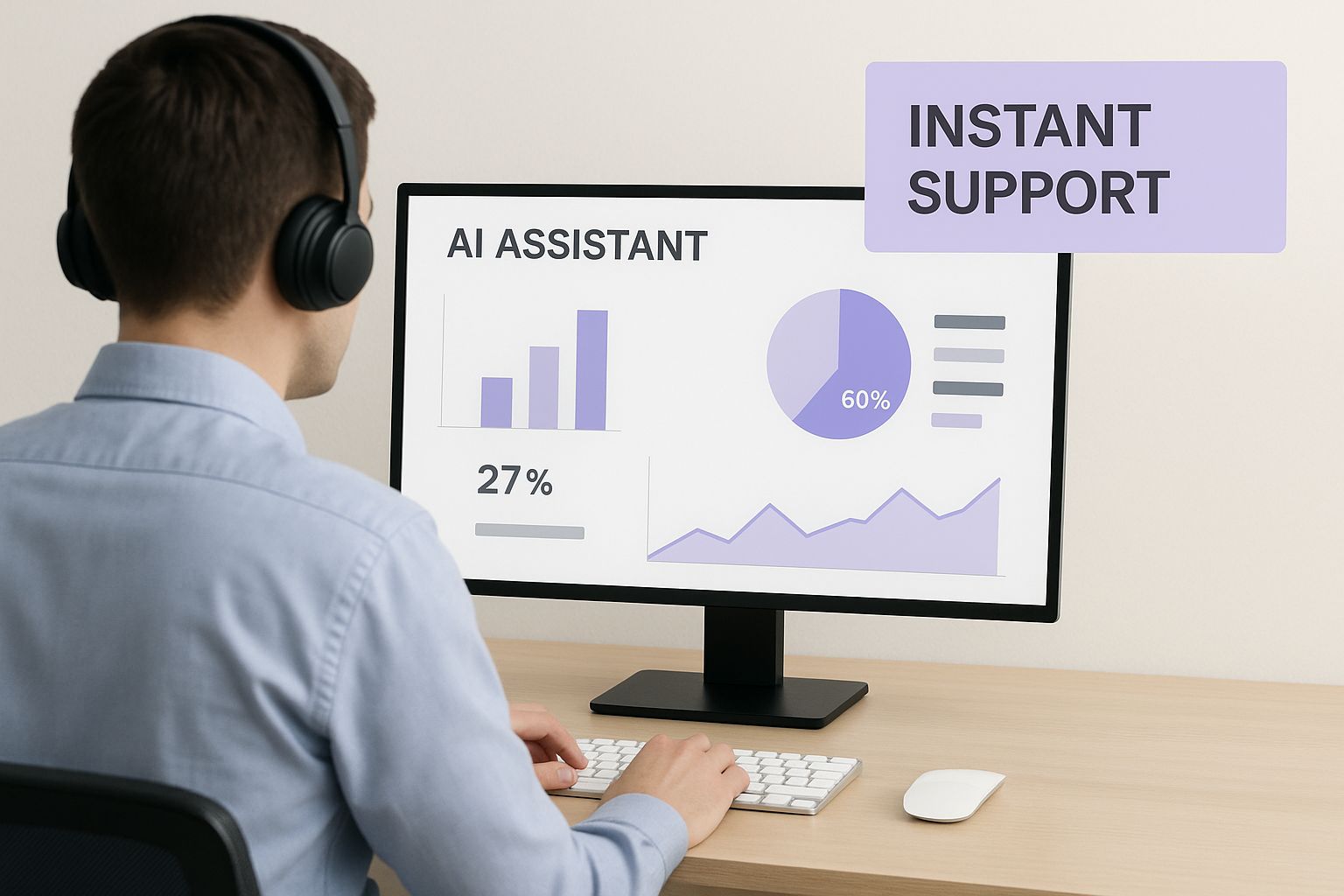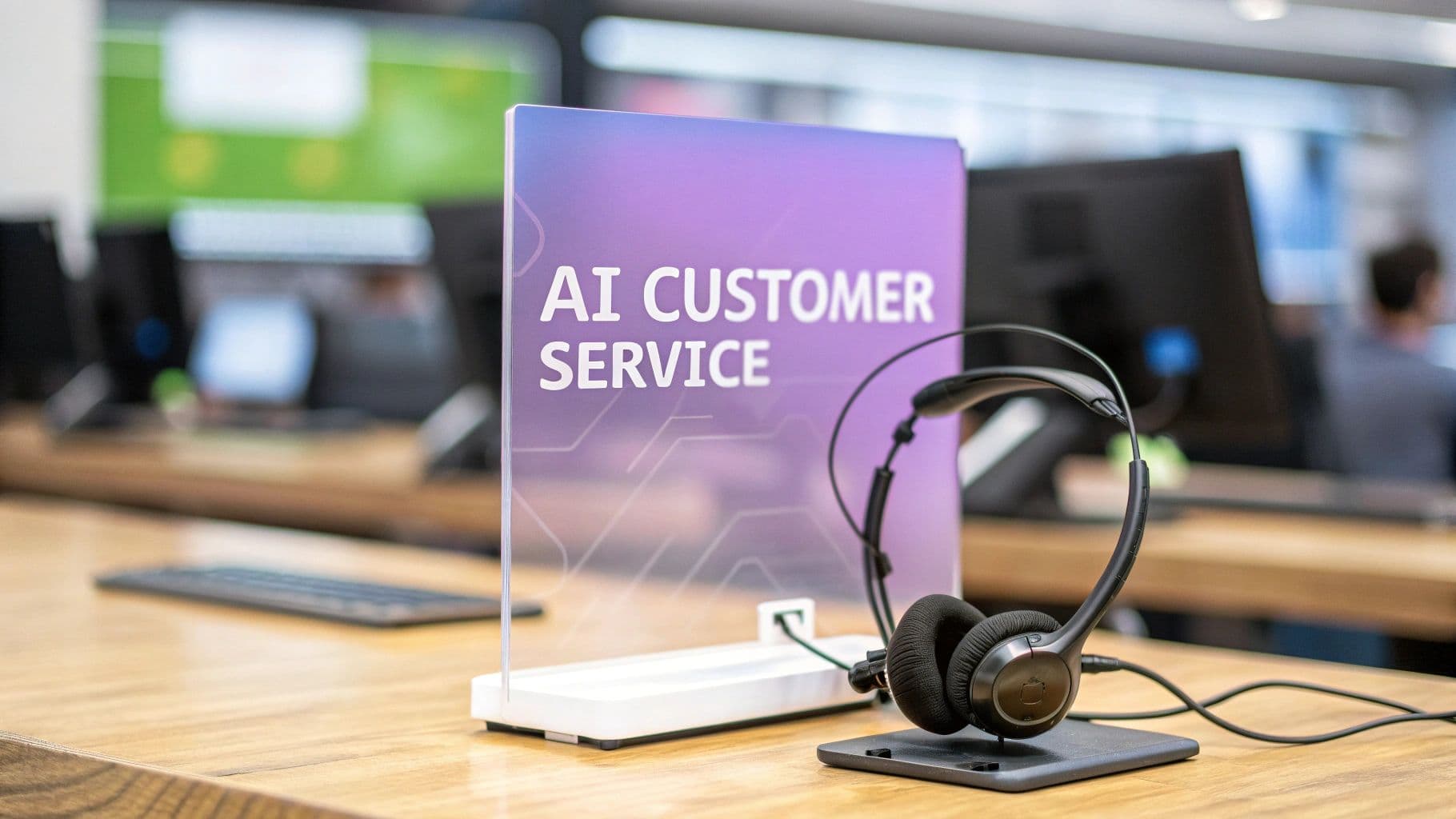The Rise of AI in Customer Support
AI is quickly changing the face of customer support, transitioning from a novel idea to a vital business tool. Companies across diverse industries are adopting AI-powered support systems to keep pace with their customers' evolving needs. This shift is fueled by rising customer expectations for rapid, personalized assistance available at all times. The demand for immediate support makes AI solutions, capable of instant replies, extremely valuable.
Why Businesses Are Embracing AI Customer Service
A key driver behind the rapid adoption of AI in customer support is the need to improve crucial performance metrics. AI-powered tools are measurably improving response times, resulting in quicker resolutions and higher customer satisfaction. For instance, Chatbots can manage a high volume of routine questions concurrently, allowing human agents to concentrate on more complex problems. This not only accelerates the support process, but also provides more individualized attention where human interaction is truly needed. These improvements directly contribute to tangible business advantages, like lower operating costs and stronger customer loyalty.
Moreover, businesses are strategically integrating AI into their customer experience strategies. They understand that AI is more than a cost-saving method; it's a powerful tool for building stronger customer relationships. By offering proactive and personalized support, businesses can cultivate greater loyalty and create a competitive edge. This allows businesses to stand out by delivering exceptional support experiences.
By 2025, AI is expected to be part of almost every customer service interaction, with 95% predicted to be handled by AI. A 2023 Gartner study found that 80% of companies already use AI to improve customer experience. More statistics can be found here: Master of Code - AI in Customer Service Statistics This significant growth reflects the widespread acknowledgment of AI's potential to reshape customer support.
The Benefits of AI in Customer Support
The advantages of implementing AI customer service are numerous, contributing to both enhanced customer experiences and improved operational efficiency. Offering 24/7 support is a significant benefit, ensuring customers receive assistance whenever needed, irrespective of time zone or business hours. This constant availability significantly boosts customer satisfaction, especially for globally operating businesses.
-
Improved Efficiency: AI automates routine tasks, freeing up human agents for complex issues.
-
24/7 Availability: AI-powered systems provide continuous support, enhancing accessibility. It also facilitates multilingual customer service, enabling businesses to engage customers in their preferred languages.
-
Personalized Experiences: AI can tailor interactions based on customer data, leading to more relevant and engaging support.
-
Scalability: AI solutions can easily manage increasing volumes of customer inquiries, ensuring consistent support during peak times.
-
Data-Driven Insights: AI delivers valuable data on customer behavior and preferences, empowering businesses to refine their support strategies.
These benefits enable businesses to meet existing customer expectations and anticipate future needs, resulting in a more proactive and efficient support approach. As AI technology continues to evolve, its importance in customer support will only grow, ultimately shaping the future of customer interactions.
How AI Chatbots Are Redefining Customer Conversations

The technology powering AI-driven customer service is constantly evolving. From basic rule-based chatbots, we've progressed to the intelligent conversational AI we see today. These systems understand context, emotion, and even customer intent. This allows AI chatbots to handle complex requests while still providing a human touch.
From Basic to Advanced: The Evolution of AI Chatbots
Early chatbots relied on simple rules. They could only respond to specific keywords, limiting their conversational abilities. Today’s Natural Language Processing (NLP) powered assistants offer a significant upgrade. They can understand and respond to human language with greater nuance, enabling more natural and effective communication.
Generative AI agents go even further. These advanced bots can create original responses and anticipate customer needs. The following data chart visualizes the growing capabilities of AI in customer service by tracking metrics across chatbot generations. Key metrics like First Contact Resolution (FCR), Customer Satisfaction (CSAT), and Average Handling Time (AHT) demonstrate how AI is improving customer service interactions. The data reveals measurable improvement with every advance in technology.
To understand the progression of chatbot technology, let's look at a comparison table:
AI Chatbot Capabilities Comparison This table compares different generations of AI customer service technologies, showing the evolution from basic rule-based systems to advanced generative AI solutions.
| Capability | Basic Chatbots | NLP-Powered Assistants | Generative AI Agents |
|---|---|---|---|
| Understanding | Keyword-based | Natural Language | Contextual & Emotional |
| Response Generation | Pre-programmed | Interpretive | Original & Predictive |
| Complexity Handling | Limited | Moderate | High |
| Personalization | Basic | Improved | Advanced |
This table clearly illustrates the evolution of AI chatbots, from basic keyword recognition to sophisticated contextual understanding and personalized interactions.
The Impact of AI on Customer Service Metrics
AI chatbots are making a real difference in key customer service areas. They're exceptionally good at handling routine inquiries, a fact recognized by 42% of industry professionals. By 2024, 31% of customer service teams had adopted chatbots. These automated systems are resolving an impressive 70% of customer issues without human intervention. This not only reduces operational costs and customer wait times but also addresses the 45% of consumers who want immediate solutions. More detailed statistics can be found here.
AI also plays a crucial role in personalizing customer interactions. AI-driven personalization helps 64% of agents tailor their responses with customer data. Meanwhile, 84% of customer service representatives report that AI streamlines ticket management workflows, making support more efficient. Industries like e-commerce and finance use AI chatbots for tasks like order tracking and fraud detection. Despite some initial skepticism, nearly half of customers now believe AI agents can understand complex emotional needs, highlighting the evolving role of AI in customer experience.
The Business Case: Measuring AI Customer Service ROI
Understanding the financial impact, operational gains, and improved customer satisfaction is crucial for any business considering AI customer service solutions. Beyond the technological advancements, the core question remains: what's the return on investment (ROI)?
Quantifying the Benefits of AI-Powered Support
Implementing AI-powered customer service offers tangible financial benefits. A primary advantage is the reduction in operational costs. Automating routine tasks lessens the dependence on large human support teams. This results in lower labor costs and increased efficiency. Furthermore, AI systems can handle a significantly higher volume of customer interactions concurrently, optimizing resource allocation.
This enhanced efficiency translates directly to improved customer satisfaction. Faster response times and 24/7 availability mean customers receive prompt support whenever needed. This cultivates customer loyalty and generates positive word-of-mouth referrals, ultimately impacting revenue growth.
Key Performance Indicators for AI Customer Service
Measuring the success of AI customer service involves tracking the right key performance indicators (KPIs). These metrics offer valuable insights into the effectiveness of your AI implementation and its impact on your business objectives.
- Cost per Ticket: Monitor how AI influences the expense of resolving each customer issue.
- Customer Satisfaction (CSAT) Score: Gauge customer happiness with AI-driven interactions.
- First Response Time: Analyze how quickly AI addresses initial customer inquiries.
- Resolution Time: Evaluate the time taken to resolve issues using AI-powered solutions.
- Containment Rate: Calculate the percentage of customer issues resolved by the AI without human intervention.
These KPIs provide a data-driven approach to understanding the true value of AI customer service. This data can then shape future strategies and optimize AI implementation for maximum impact. Let's take a look at the following table which showcases some average ROI metrics.
To better understand the potential return on investment, consider the following table outlining key metrics and typical improvements seen by businesses adopting AI customer service:
"AI Customer Service ROI Metrics" "Key performance indicators and average improvements reported by businesses implementing AI customer service solutions"
| Metric | Average Improvement | Implementation Timeframe | Industry Benchmark |
|---|---|---|---|
| Cost per Ticket | 10-15% Reduction | 6-12 Months | $5-$10 |
| CSAT Score | 5-10% Increase | 3-6 Months | 75% |
| First Response Time | 20-30% Decrease | 1-3 Months | <5 Minutes |
| Resolution Time | 10-20% Decrease | 3-6 Months | <24 Hours |
| Containment Rate | 20-30% Increase | 6-12 Months | 50% |
As the data indicates, businesses often see significant improvements across several key metrics within a reasonable timeframe after implementing AI solutions. These improvements demonstrate the potential for a strong ROI and positive impact on customer experience.
Building a Compelling Business Case for AI
Constructing a strong business case requires showcasing the clear benefits of AI customer service. Begin by pinpointing your organization's specific needs and challenges. Then, link those challenges to how AI can provide solutions. For instance, if your objective is to reduce support costs, emphasize how AI can automate routine tasks and free up human agents for more complex issues.
The current customer service AI market prioritizes transparency and security, with evolving standards emphasizing ethical data use and explainable AI. Hybrid human-AI models are common, with 60% of support leaders prioritizing AI for faster response times while maintaining a personal touch. More detailed statistics can be found here. Focusing on the long-term strategic advantages of AI, such as predictive care, can fortify your business case and secure stakeholder buy-in. Companies currently leveraging AI report improved CSAT scores and a 10-15% decrease in per-ticket costs.

Finding the Sweet Spot: Automation With a Human Touch

The most effective AI customer service strategies focus on combining the strengths of both artificial intelligence and human agents. This blended approach creates a synergy that boosts efficiency while preserving the personal touch customers value.
Balancing AI and Human Interaction
Leading companies are adopting hybrid support models. These models leverage AI for tasks such as answering FAQs, providing immediate support, and collecting initial information. This allows human agents to dedicate their time to more complex or emotionally charged interactions.
Think of it as a team effort: AI lays the groundwork, and human agents step in when empathy and deeper understanding are essential. This division of labor requires careful planning. AI excels at processing large amounts of data and identifying trends, making it perfect for tasks like routing inquiries and offering personalized product suggestions.
However, situations involving empathy, complex problem-solving, or conflict resolution benefit from human interaction.
Strategies for Seamless Handoffs
A smooth transition between AI and human agents is crucial for a successful hybrid model. This involves clear escalation paths and ensuring all necessary information is shared during the handoff.
Imagine a customer interacting with an AI chatbot. The chatbot gathers initial details, but the issue requires a more nuanced approach. The AI seamlessly transfers the conversation to a human agent, including all collected data, creating a smooth and positive experience.
Here are some key strategies for seamless transitions:
- Context Preservation: Transfer all pertinent information from the AI interaction, including conversation history, customer preferences, and any other gathered data, to the human agent.
- Clear Communication: Let the customer know when and why the interaction is being transferred.
- Agent Training: Provide human agents with the skills and tools to effectively handle escalated inquiries.
Maintaining a Consistent Brand Voice
Whether a customer interacts with an AI chatbot or a human agent, the experience should feel consistent. This means maintaining a unified brand voice across all communication channels. This consistency reinforces brand identity and builds customer trust.
Imagine a customer chatting with a friendly, informal AI bot, then being transferred to a human agent with a formal, impersonal tone. This inconsistency can be disruptive. However, a consistent tone and style between AI and human agents create a seamless and positive experience. FlowGent AI allows businesses to customize agent profiles to match their brand voice and operational needs, ensuring consistent interactions across all channels.
FlowGent AI's multi-step workflow builder and knowledge-base integrations further strengthen this brand consistency. Maintaining consistency across every customer service touchpoint, whether it's an initial chatbot interaction or a follow-up call with a human agent, ensures a positive customer experience aligned with your brand identity. This strategy helps customers feel valued and understood, regardless of how their inquiry is handled.
Implementing AI Customer Service: Your Strategic Roadmap
Ready to move from the drawing board to real-world implementation? This digital transformation roadmap simplifies the process of bringing AI customer service to your business, breaking it down into clear, actionable steps. We'll guide you through each stage, from the initial assessment to complete integration.
Assessing Your Needs and Defining Objectives
The first step is to pinpoint your specific business needs and the challenges you want AI customer service to address. Are you aiming to decrease customer wait times? Do you want to boost your first contact resolution rates? Perhaps your goal is to elevate overall customer satisfaction? Clearly defined objectives are the cornerstone of successful implementation.
For instance, if handling a high volume of routine inquiries is your primary concern, an AI chatbot might be the perfect solution. However, if personalized upselling is your focus, a more advanced AI integrated with your CRM data would be a better fit. Understanding your goals will inform your choice of the right AI solution.
Choosing the Right AI Customer Service Solution
Once you have a solid grasp of your needs, you can start evaluating different AI platforms. Consider key factors such as the platform's features, integration capabilities, and scalability. FlowGent AI offers no-code tools for deploying AI agents across multiple communication channels, simplifying the implementation process.
Its integration with existing business systems ensures seamless data exchange and streamlined workflows. This ensures the platform you choose aligns with your current infrastructure and supports your future growth.
Data Preparation and Integration
Data is the lifeblood of AI systems. You can link AI agents to popular SQL databases to ensure seamless data access. Preparing your existing customer data and integrating it with your chosen AI platform is crucial. This involves cleaning your data, verifying its accuracy, and structuring it for optimal AI utilization.
Think of your data as the fuel that powers your AI engine. The cleaner and more refined the data, the better the AI performs. FlowGent AI's knowledge-base integrations enable your AI agents to learn from your existing data, equipping them to handle customer inquiries effectively.
Phased Implementation and Change Management
A phased implementation approach minimizes disruptions and allows for adjustments as needed. Begin by deploying your AI solution to a small segment of your customer base or for specific types of inquiries. This pilot phase provides valuable insights for testing and refining the system before a full-scale rollout.
Introducing AI can sometimes encounter internal resistance. Effective change management, through clear communication and comprehensive training, is crucial for team adoption. By empowering your team and demonstrating the benefits of AI, you can foster a collaborative environment and maximize the potential of your new AI customer service system.
Ongoing Monitoring and Optimization
Even after full deployment, continuous monitoring and optimization are essential. Track your key KPIs and analyze conversation logs to identify areas for improvement. FlowGent AI's real-time analytics dashboard provides valuable data for monitoring performance and refining your AI agents.
This data-driven approach ensures your AI customer service solution continues to deliver value and adapts to your evolving business needs. This constant evolution allows your AI to remain effective and responsive to the changing dynamics of customer interactions.
The Future of AI Customer Service: Emerging Possibilities
The AI customer service landscape is constantly evolving. What does the future hold for customer support? By analyzing current trends and expert insights, we can glimpse the exciting possibilities shaping the next generation of support experiences.
Predictive Service and Proactive Support
Imagine a support system that anticipates your needs before you even realize them. Predictive service models analyze customer data to predict potential issues and proactively offer solutions. This transforms customer service from a reactive process to a proactive one, resolving problems before they escalate.
For example, if a customer's internet service has repeated outages, a predictive model could automatically schedule a technician visit or offer a proactive discount. This proactive approach minimizes customer frustration and strengthens relationships. Proactive support means addressing customer needs before they become major problems, leading to increased satisfaction and loyalty.
Multimodal AI for Richer Interactions
Multimodal AI moves beyond text-based interactions, processing visual and audio input to create richer, more human-like conversations. Imagine a customer showing a chatbot a photo of a damaged product. The AI could analyze the image, understand the issue, and guide the customer through the return process.
This capability unlocks exciting possibilities for more intuitive and efficient support. Instead of relying only on text descriptions, customers can communicate using images, voice recordings, or even video. This makes interactions more natural and efficient. This enhanced communication creates more personalized and effective support experiences.
Hyper-Personalization: Tailoring Experiences to Each Customer
AI is pushing the boundaries of personalization. Hyper-personalization uses advanced algorithms to create support experiences tailored to each individual customer's preferences and past interactions. This fosters a sense of being truly understood and valued.
Imagine AI remembering your past interactions, product preferences, and even your preferred communication style. This allows for personalized recommendations and proactive support aligned with each customer's unique needs. This level of personalization enhances customer loyalty and builds stronger customer relationships.
Ethical Considerations and Responsible AI Development
As AI becomes more deeply integrated into customer service, addressing ethical considerations is paramount. Ensuring data privacy, transparency in AI decision-making, and avoiding bias are crucial for responsible AI development.
Regulations, such as the EU AI Act, are emerging to establish standards and guidelines for AI usage. Understanding these regulations and incorporating ethical practices from the beginning is vital for long-term success and maintaining customer trust. This responsible approach builds customer confidence and promotes the sustainable development of AI in customer service.
Ready to transform your customer service with AI? FlowGent AI empowers you to deploy intelligent AI agents across various channels, automating support and boosting efficiency. Learn more and start your free trial today.



